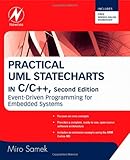Found in 3 comments on Hacker News
lj3 · 2017-07-24
· Original
thread
Practical UML Statecharts in C/C++: Event-Driven Programming for Embedded Systems by Miro Samek.
https://www.amazon.com/Practical-UML-Statecharts-Event-Drive...
erichocean · 2012-12-24
· Original
thread
This book[1] seems to really help people (don't be put off by the title):
Practical UML Statecharts in C/C++: Event-Driven Programming for Embedded Systems
In particular, it discusses the main implementation strategies and why you'd want to use them. Also, the specific codebase described in the book is excellent. I use it all the time in implementing server software.
[1] http://www.amazon.com/Practical-UML-Statecharts-Second-Event...

For example, reviewing a bunch of the javascript SM libraries I see a few have the SM define a "transition table". This works for simple SM but makes it difficult to conditionally transition. Perhaps we want our bank account SM to automatically transition to the "hold" state if the balance goes below zero. With a fixed (i.e. as configuration) transition table we can't do this (or we have to fight against the SM library, or the SM library has to be more complicated).
I guess I'm fairly influenced by this book: https://www.amazon.com/Practical-UML-Statecharts-Event-Drive... I found that approach worked very well when I used it to implement a fairly sophisticated UI on an embedded device. It was easy to rationalize about, easy to read in the code, and easy to maintain (add/move states). Seems like something similar in javascript would be nice, except doing things in a javascript way.